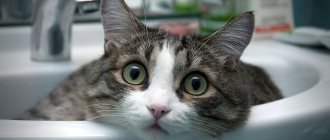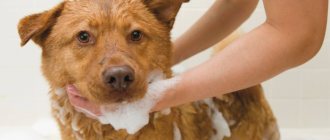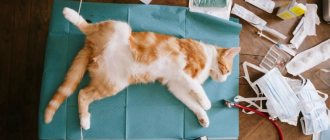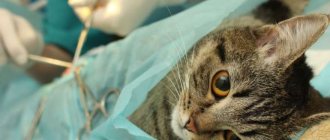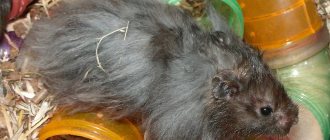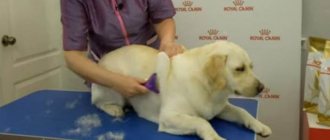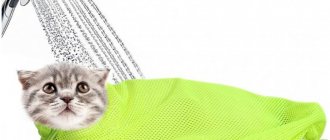Castration of pets is one of the most popular manipulations in veterinary practice, relieving the pet of sexual desire. As a result, the cat’s behavior becomes calmer, the animal does not show aggression and lives 1.5-2 years longer than unsterilized cats. You will no longer have to deal with the unpleasant smell in the house, listen to heartbreaking howls at night and feed your pet so-called harmless hormonal drugs, which often cause the development of oncology and other life-related disorders.
What is cat castration
Castration of cats can be medical or surgical. The result of manipulation is temporary or complete suppression of libido and elimination of the sexual instinct. The most popular is surgery, which is performed under general anesthesia. During the operation, the surgeon removes the testicles (testes) located in the scrotum or, in cryptorchidism, outside it.
The following types of anesthesia are used:
- inhalation;
- local;
- non-inhalation;
- combined method.
The choice of anesthesia depends on the health of the animal and the specifics of the surgical protocol. The optimal age for surgery and painless rehabilitation is from 7 to 9 months.
Medical or chemical castration allows you to do without surgery and anesthesia. During an alternative procedure, an implant with an active substance is implanted under the pet’s skin, which inhibits the production of androgens, changes hormonal levels and behavior. The effect lasts quite a long time - from 6 months to 3 years, there is no need to care for the installation site, no rehabilitation is required. The peculiarity of the procedure is that at any time, if necessary and plans change, the implant can be evacuated, after which the hormonal levels will be restored and the animal will again be ready for mating. Among the disadvantages, one should note the high cost and the presence of a reverse effect during the first 2-4 weeks after installation.
After the operation and the postoperative period, the neutered animal stops marking furniture, which makes it easier to care for and becomes more friendly towards people and other household inhabitants. Owners note an improvement in the furry cat’s psychological state and behavior, and the likelihood of getting injured in street fights over the cat with other males is minimized. Changes in hormonal levels after castration affect the formation of character - street life ceases to be attractive to the cat, so you do not have to close the windows for fear of escape.
Seasonality. Is it possible to wash cats in winter?
During the cold season, temperature changes can affect the weather, sometimes causing colds in cats.
In winter, it is recommended, if possible, to stop washing for a while (until spring).
If, due to the nature of its life, the animal needs regular bathing, you can increase the interval between grooming procedures. In this case, the cat should be washed every 2 months. Such terms are agreed upon for cases where, under normal conditions, the animal is bathed monthly.
How is castration performed?
Cat owners most often opt for the classic castration procedure due to its simplicity, affordable cost, short postoperative period and low likelihood of complications. Preparation for surgery involves choosing a clinic, weighing and examining the pet (the list of necessary measures and their features is determined by the doctor individually), and determining medical contraindications. You cannot feed your fluffy 12 hours before the scheduled time of surgery, and you should refuse water 2-3 hours before the procedure.
There are two options for castration:
- doping of the testicular cord with a surgical thread - the surgeon ties the cord with suture material, which does not need to be maintained;
- without the use of a ligature - the spermatic cord in this case is formed into a biological unit, patient care is identical.
After applying anesthesia, the doctor must prepare the surgical field, freeing it from hair, and treat the scrotum and the adjacent area with an antiseptic solution. Next, dissection is performed with a scalpel. The spermatic cords are clamped, and the testes are excised and removed. Considering that the intervention area is small, sutures are not always advisable, and therefore there is no need to care for them. The incision site is treated with an antiseptic; complete healing usually occurs after 7-10 days, subject to the prevention of complications and proper care. At the end of the surgical procedure, the cat remains in the clinic under the supervision of staff who will care for him until he is finally recovered from the state of anesthesia. Typically this period is about an hour or more, subject to the presence of negative effects of anesthesia and other features.
Adult cat's first bath
If you happen to take an older animal into your home, you need to understand how to bathe it in order to reduce stress. To begin with, it is recommended to familiarize the animal with the environment: it is brought into the room, you can even put it in the bath. Soon after this, you are allowed to wash your pet.
Adult cats that have not previously been in contact with large amounts of water should also be actively distracted from the procedure at first: toys are placed at the bottom of the bath; the more interesting and varied they are, the easier it is to entertain a new friend.
You need to introduce the cat to water gradually: first, pour the liquid to a level of 2-3 cm above the surface of the bathtub or basin. Gradually the amount of liquid is increased. The bathing procedure is standard.
Rules and important care notes for owners
Full recovery and rehabilitation of a pet after surgery requires patience on the part of the owners. Do not force feed or scold the fluffy if he does not have time to reach the tray or relieves himself in the wrong place. Don’t forget that your pet has experienced extreme stress and may experience pain, so surround him with affection and care and let him know that you are nearby and ready to care for him. You should not bathe the animal for a month after surgery - cleaning should be postponed until the postoperative wound has completely healed. You need to care for the wound using wet wipes or cotton pads soaked in water.
Proper care should be provided and the cat’s health should be closely monitored after castration. The following points should alert the owner:
- Even a slight increase in body temperature in the postoperative period should be a reason to contact a veterinarian. A change in temperature may indicate the addition of an infectious process;
- Refusal to eat for more than 24 hours, increasing weakness, lethargy and apathetic behavior - the development of such symptoms jeopardizes the rapid rehabilitation of the animal and requires consultation with your doctor;
- Changes in the appearance of the wound - if you properly care for the wound, the incision site should be dry (except for the first day) without signs of suppuration. If, after 24 hours after castration, bleeding and exudate are observed, you should play it safe and show the cat to a specialist for an examination and organization of competent care;
- Periodically palpate the cat’s abdomen - if during palpation the abdomen is tense and the pet experiences pain, you should suspect the development of complications and seek veterinary help to prevent complications;
- You should also contact a veterinarian if abnormalities in the cardiorespiratory system develop. The development of shortness of breath and rapid heartbeat are serious symptoms that require emergency care, and such a patient must be cared for in a hospital.
To avoid the development of complications and other health problems for your cat, you should follow your doctor’s recommendations during rehabilitation. High-quality care and care will allow the cat to quickly forget about the stress he suffered and recover after castration as soon as possible.
Kitten's first bath
The risk of developing colds due to temperature changes in children is much higher. For this reason, negative factors are excluded: drafts, cold air at home.
It is recommended to wait until the teeth are completely replaced. After this, you can wash the kitten, but wait an additional 2 weeks. The sequence of actions is the same as when bathing older pets.
First you need to show the kitten that water is not dangerous:
- the animal is transferred to a small container, only the paws are wet for now, and the rest of the body can be washed when the baby gets used to the new environment;
- To distract the kitten, they leave toys, blow bubbles for the same purpose, or perform other entertaining tricks.
Toilet
As soon as the cat begins to stand up, it is necessary to place a litter tray with low sides near the bed. It is better to add a filler (silica gel is better, it does not create dust and dirt) that is light in color, so that you can immediately see if there is bleeding or pus.
If the cat avoids the toilet in the first days, this is understandable. Firstly, he had hardly eaten or drunk anything yet. Secondly, he experiences pain and discomfort and delays this moment. As a last resort, you can give your pet a little Vaseline oil.
It’s also okay if the cat goes to the toilet in small portions. This is normal for the first days. Within a month everything should be back to normal. And, most importantly, the urine will no longer have a pungent odor.
Transporting a pet
When the animal wakes up and can be taken home, use a special carrier or basket with soft bedding. Please note that at any moment the cat may involuntarily vomit or urinate - be prepared to replace the bedding.
After laying the animal down, cover it with a warm blanket and, if possible, place a heating pad on the back. Do not apply a heat source close to the incision site as this may cause increased bleeding. Small plastic bottles filled with warm water can be used as heating pads.
Do not transport your cat on public transport - excessive shaking and jostling will be additional stress for him.
Until your pet recovers from anesthesia, you will have to periodically take care of your eyes: unlike people, cats under anesthesia do not have their eyelids closed, and you need to make sure that the conjunctiva does not dry out - use antiseptic drops.
Possible postoperative complications
Complications after planned surgical interventions develop extremely rarely and, in most cases, it depends on the individual characteristics of a particular animal.
Main postoperative complications:
- Prolonged post-anesthesia hypothermia. If a cat lies for a long time without moving, and its ears and paws feel cold to the touch, it is necessary to check its body temperature. If the readings are below 37°C, you need to put the cat on a warm heating pad, cover it with any natural piece of fabric and contact your veterinarian for advice.
- Intra-abdominal bleeding. If traces of fresh blood are detected in the suture area or from the vulva, with obvious pain in the abdomen and pallor of the skin, you should immediately take the cat to a veterinary hospital to stop possible bleeding in the abdominal cavity. If internal bleeding is confirmed, then repeated surgery is performed.
- Postoperative hyperthermia. If body temperature is elevated for more than 3 days (above 39°C), it is necessary to consult with a veterinarian or take the cat to an appointment for direct examination by a specialist.
- Redness around the stitch and swelling. This condition of the suture is allowed for 3-5 days, provided that there is no discharge from the wound. After 5 days, both redness and swelling will begin to subside and will completely disappear by the time the stitches are removed.
- Rotting postoperative suture. If the cat's postoperative hygiene measures are not followed, dirt may get into the seam, causing it to fester. It is imperative to show the animal to a doctor. If the prescribed drugs for local treatment do not help eliminate such signs, the doctor will have to remove the stitches, remove the damaged areas of skin around the wound under anesthesia and re-suture it.
- Lump on the abdomen in the suture area. If an enlarged area is detected anywhere around the seam, this is a reason to consult a veterinarian. There are two options for lumps after sterilization - this is post-operative swelling, which may have to be opened, or the growth of granulation tissue (“young” skin), which will go away on its own within a month and a half.

